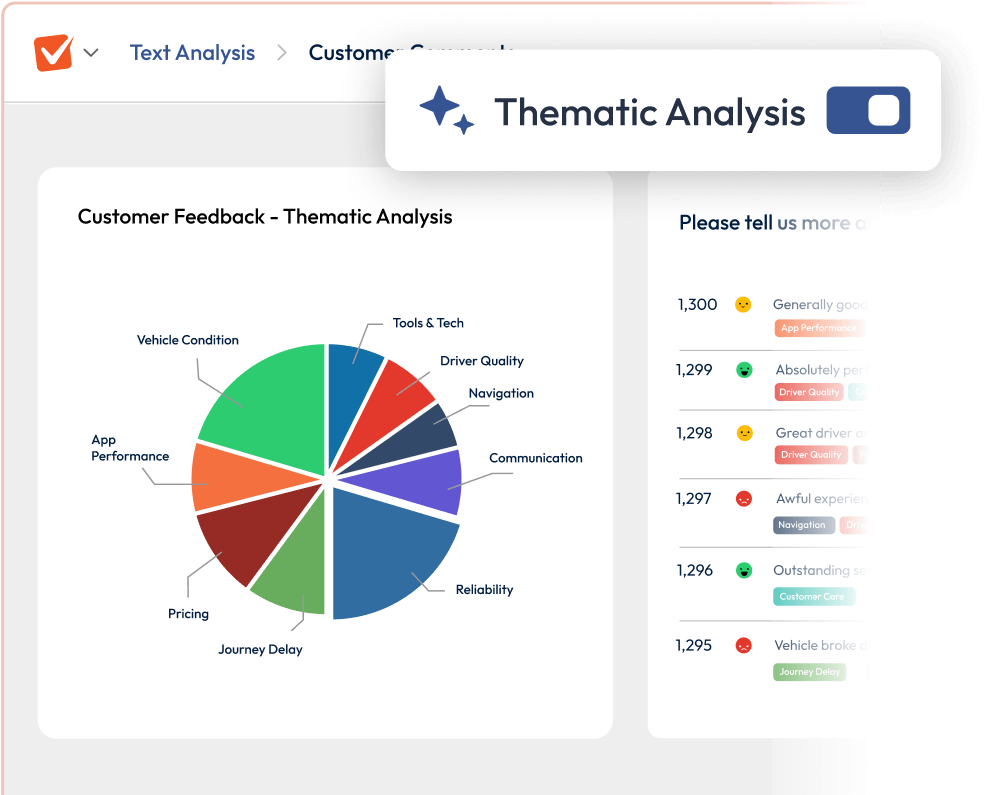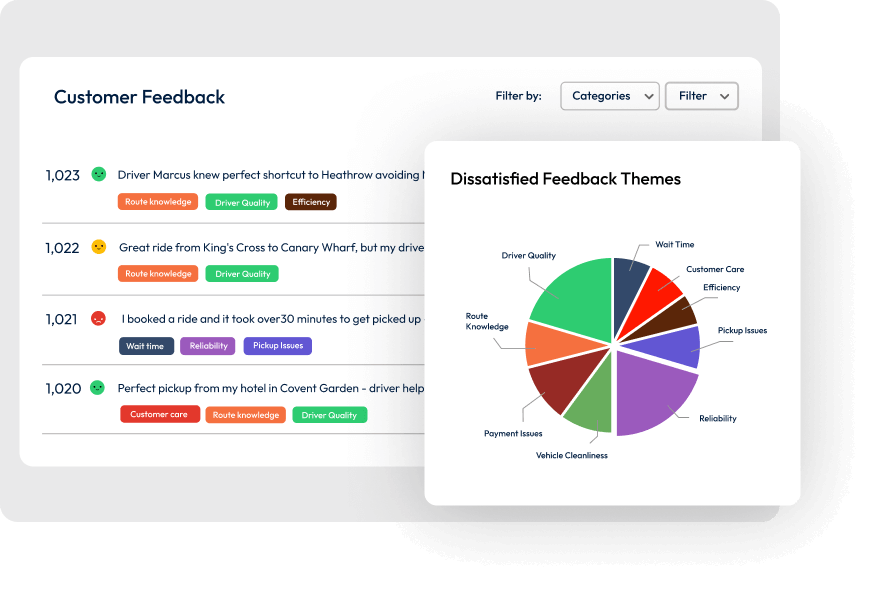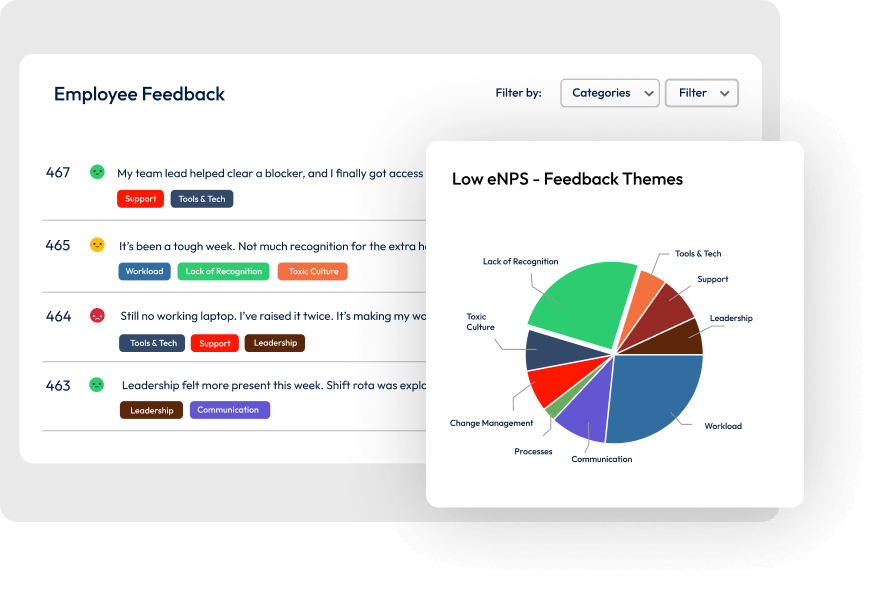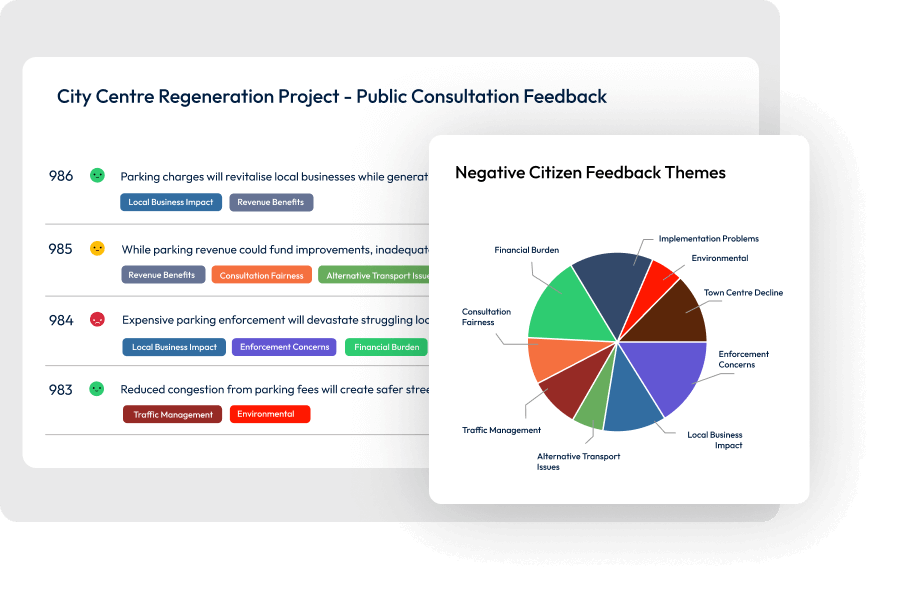From open text to insights in seconds
Get a personalised demo of SmartSurvey. Customised to your goals, led by our experts.


Say goodbye to manual analysis.
Let AI do all of the heavy lifting.
Stop reading, start acting
AI spots the themes that matter most, so you can fix problems before they grow.
Weeks of work in seconds
Analyse thousands of responses instantly - get answers while the feedback is still fresh.
Never miss what matters
Every piece of feedback understood instantly - catch issues before they escalate.
“Thematic Analysis has transformed our feedback analysis, saving us days of manual work with its remarkable speed, reliable accuracy, and data visualisations.”
Bryn Mabey, Communications Lead, Lewes District Council and Eastbourne Borough Council
Interactive demo – try it out for yourself
Calculate how much time Thematic analysis will save
Learn how much you can save with SmartSurvey
What Thematic Analysis does for you
Save weeks of work
Skip the manual categorisation process entirely
- Categorise feedback the moment it arrives
- Eliminate days of manual work
- Frees your team to solve problems
Spots risks early
Catch issues buried in feedback before it's too late
- Identifies emerging problems automatically
- Alerts you to urgent customer concerns
- Catch problems early before they escalate
Set & forget
Automates categorisation for all incoming feedback
- Works continuously once you switch on
- Processes new responses the moment they arrive
- Keeps your insights current without ongoing effort
Eliminate bias
Get an objective view of your customer feedback
- Analyses comments without preconceived notions
- Discovers unexpected themes you might overlook
- Ensures consistent categorisation across responses
Use cases
Uncover root causes
Identify patterns in feedback to solve recurring issues
Thematic Analysis detects recurring themes in customer complaints, like staffing shortages or website glitches, helping CX teams uncover root causes. By addressing these issues, teams can improve service quality and boost customer retention.


Diagnose retention risks
Group feedback to uncover why employees leave
Thematic Analysis analyses employee feedback to uncover recurring themes like workload, career growth, and leadership issues. By identifying patterns in surveys and exit interviews, HR can address attrition risks and improve retention.
Analyse public consultation feedback
Uncover key objections to major infrastructure projects
Thematic Analysis helps Local and Central government quickly organise unstructured feedback from public consultations highlighting key concerns like environmental impact, traffic disruptions, and costs, improving engagement and transparency.

FAQs
Thematic analysis helps you spot patterns and themes in open-ended survey responses. Instead of reading through hundreds of comments manually, you can group similar ideas together to understand what people are really saying. SmartSurvey's Text Analysis feature lets you tag responses manually, whilst AutoCategorise (our thematic analysis tool) uses AI to do the heavy lifting automatically.
In qualitative research, thematic analysis uncovers the deeper meaning behind what people tell you. Whether you're analysing interviews, focus groups or survey responses, it helps you identify recurring themes that go beyond just counting responses. SmartSurvey supports this with both manual Text Analysis tools and AI-powered AutoCategorise.
Braun and Clarke's method has six stages: getting familiar with the data, coding it, finding themes, reviewing them, naming them, and then writing up your analysis. SmartSurvey's AutoCategorise feature can help with the coding and theme-finding stages, saving you loads of time.
Imagine survey comments like ‘long wait time’, ‘slow service’, or ‘terrible delays’. Through thematic analysis, you'd group these into a theme called ‘Service Speed Issues’. With SmartSurvey, you can either tag these manually using Text Analysis or let AutoCategorise spot these patterns and group them automatically.
Reflexive thematic analysis is where you, as the researcher, actively interpret what themes emerge from the data rather than following rigid rules. SmartSurvey supports this approach by letting you manually categorise responses with Text Analysis, or you can start with AutoCategorise suggestions and refine the themes based on your own insights.
Yes. SmartSurvey offers both manual Text Analysis for hands-on thematic work and AutoCategorise for automated theme detection. AutoCategorise uses AI to group similar responses into themes automatically, whilst Text Analysis gives you complete control over how you categorise and analyse your data.
AutoCategorise reads through your open-ended responses and groups similar answers into themes automatically. You set up categories based on what you're looking for, and it sorts responses accordingly. You can then review, adjust or rename these themes using SmartSurvey's Text Analysis tools to make sure they match your research needs.
Yes. SmartSurvey automatically detects whether responses are positive, negative or neutral. This works alongside both Text Analysis and AutoCategorise (thematic analysis), so you can understand not just what themes emerge, but how people feel about each topic.
Absolutely. Whether your responses are from last week or last year, you can use SmartSurvey's Text Analysis and AutoCategorise features on any open-ended response in your surveys. This is perfect for comparing themes across different time periods or re-analysing data with fresh perspectives.
Yes, it is. SmartSurvey provides both manual Text Analysis tools for detailed thematic work and AutoCategorise for efficient pattern detection. This flexibility makes it suitable for rigorous academic research as well as commercial studies where you need quick insights from open-ended responses.